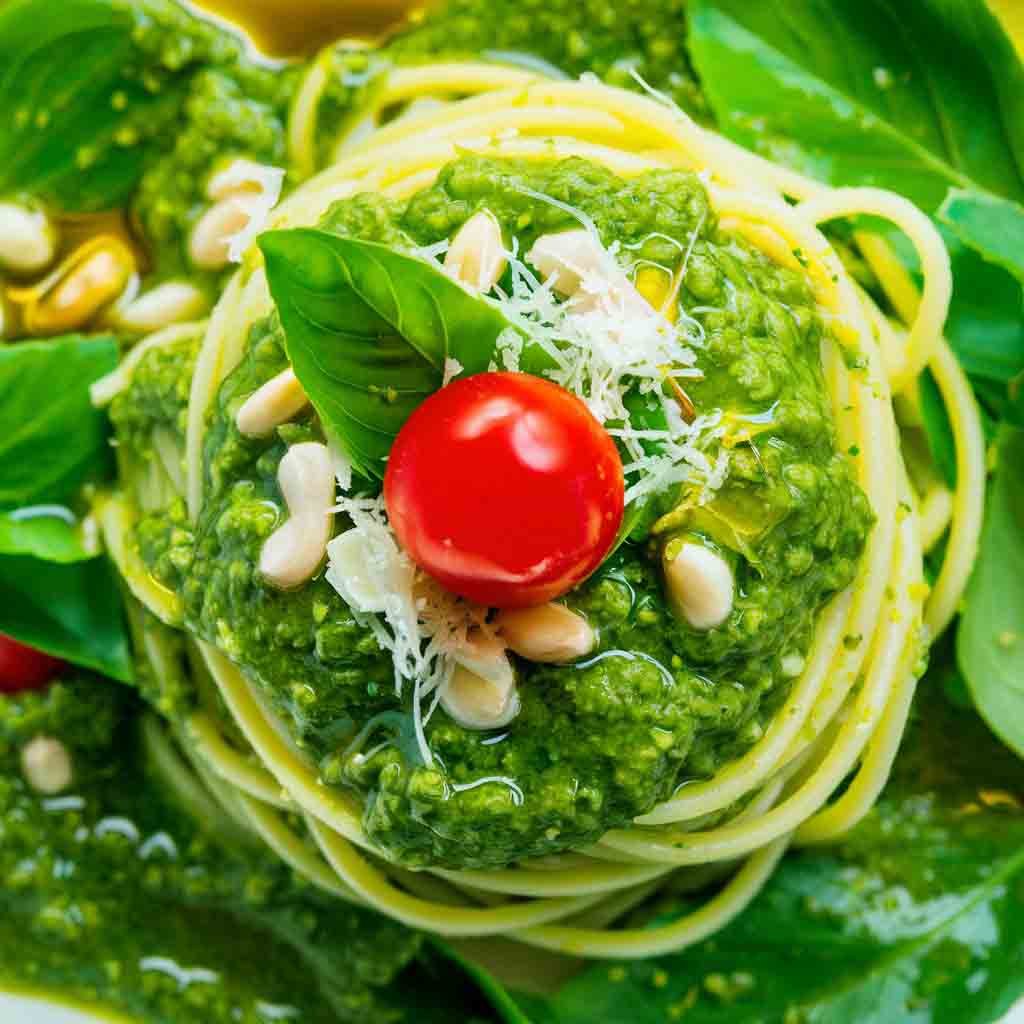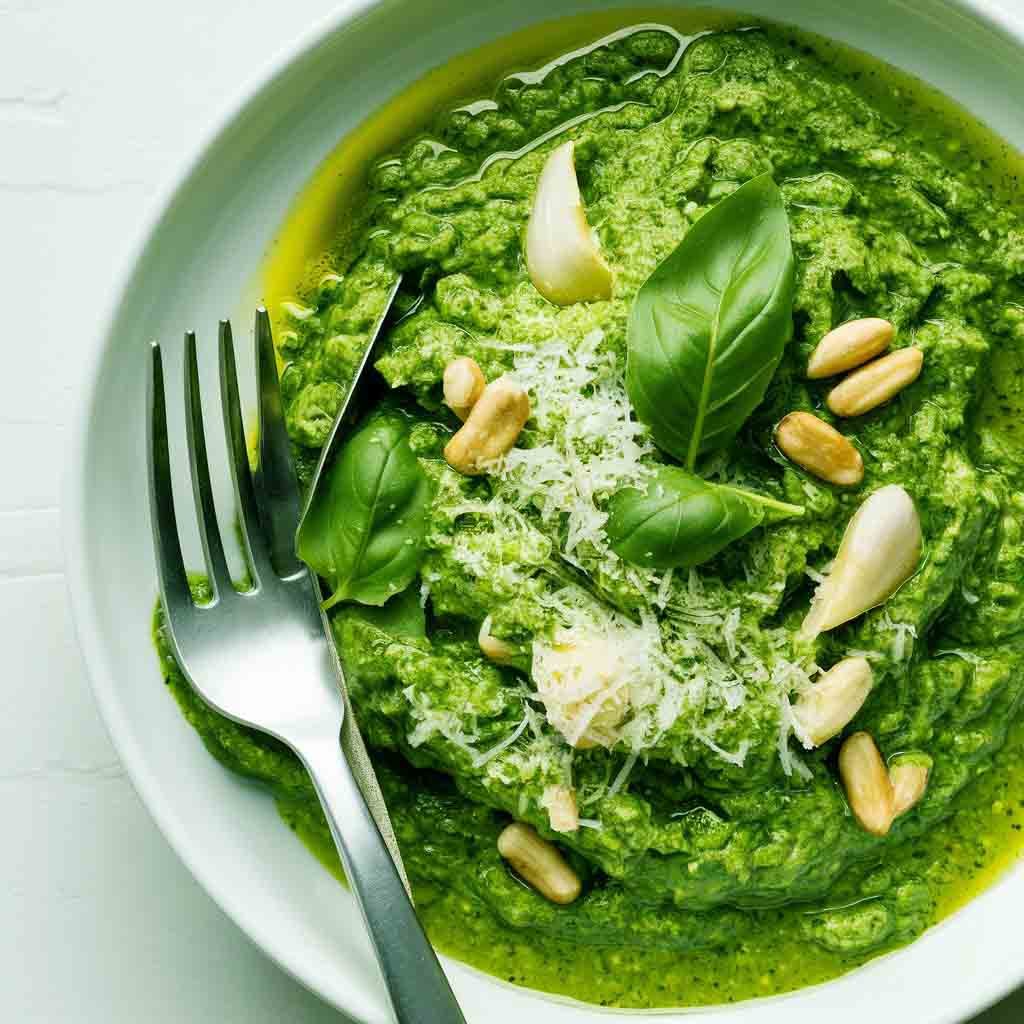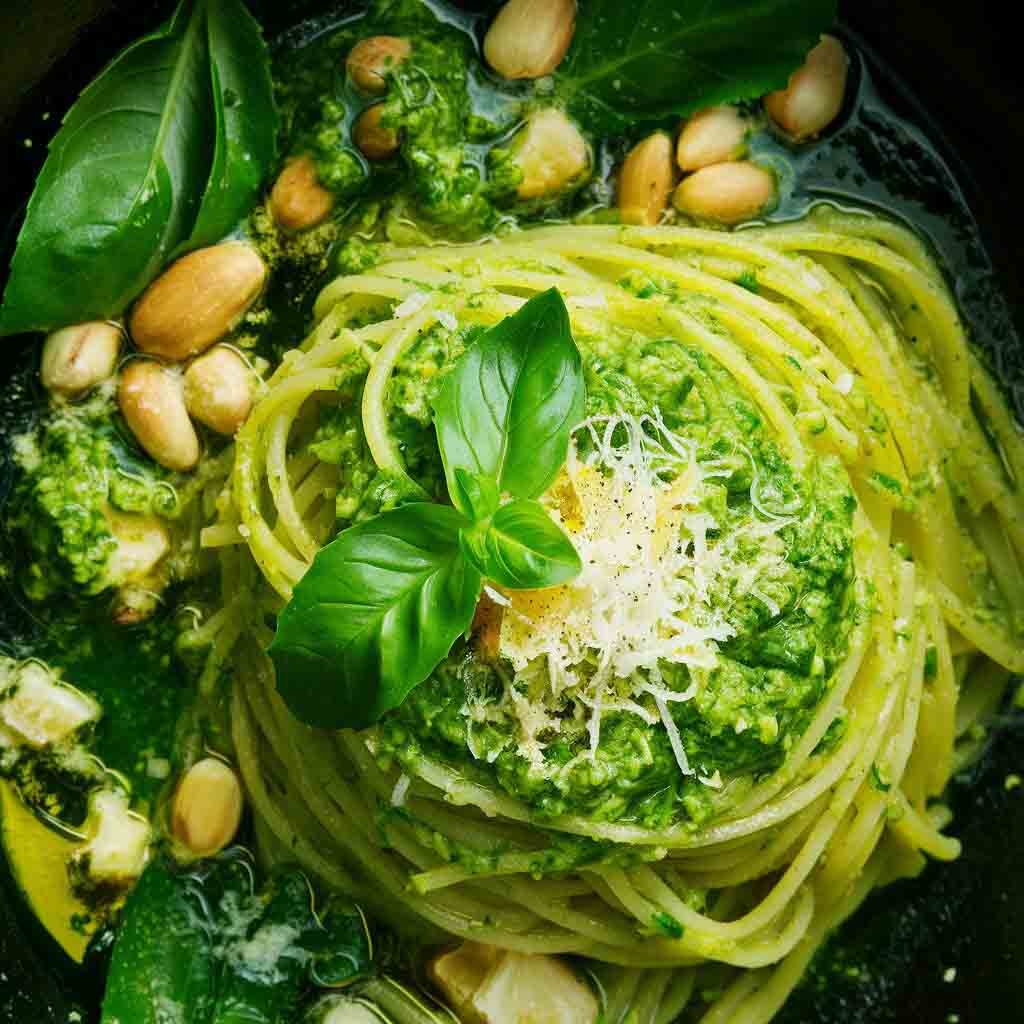
The best pesto recipe combines fresh basil, Parmesan cheese, pine nuts, garlic, and olive oil. Blend these ingredients for a vibrant, classic sauce.
Pesto, the aromatic blend hailing from Genoa, Italy, is a versatile sauce that has won the hearts of food lovers globally. Its simplicity allows for quick preparation, making it a go-to for busy weeknights or sophisticated gatherings. The key to a perfect pesto lies in the quality of its components; fresh basil leaves, high-quality extra virgin olive oil, and genuine Parmesan cheese elevate the flavors.
This sauce pairs beautifully with pasta, crusty bread, or as a delightful drizzle over grilled meats and vegetables. Its bright green hue and rich, nutty taste not only enhance the visual appeal of dishes but also provide a burst of Italian flair to any meal.
The Essence Of Authentic Pesto
The secret to capturing the heart of Italian cuisine lies in mastering the authentic pesto. This vibrant green sauce bursts with flavor and tradition. It transforms simple dishes into gourmet delights. Let’s unveil the magic behind the best pesto recipe.
Key Ingredients
Key ingredients are the backbone of any pesto. They define its taste and quality. Here’s what you’ll need:
- Fresh basil leaves – the star of the show
- Pine nuts – for a nutty crunch
- Garlic – adds a spicy kick
- Fine Parmesan cheese – brings a salty depth
- Extra-virgin olive oil – for a smooth blend
- Sea salt – to enhance flavors
The Role Of Fresh Basil
Fresh basil gives pesto its iconic color and aroma. It’s essential to choose leaves that are bright and lush. These impart a peppery yet sweet taste. Basil is the essence of pesto, so it must be fresh!
| Basil Type | Flavor Profile |
|---|---|
| Genovese | Classic, sweet |
| Sweet Basil | Mild, versatile |
| Purple Basil | Intense, colorful |
Choosing The Right Basil
For a flawless pesto, basil selection is key. The right basil variety ensures a fragrant, vibrant pesto. Let’s dive into the best choices for your recipe.

Types Of Basil
Basil comes in many varieties, each with unique flavors and aromas. Sweet basil is the most popular for pesto. It has a fresh, peppery taste. Genovese basil is another favorite, prized for its bright, slightly sweet flavor. For a twist, try lemon basil or Thai basil, which add a citrusy or spicy kick.
Storing And Prepping Basil
Proper storage and prep can make or break your pesto. Keep basil fresh by storing it in the fridge, wrapped in a damp paper towel. Before use, wash leaves gently and pat them dry.
Remove leaves from stems, as stems can be bitter. Use the freshest leaves for the best taste. Now, you’re ready to make a pesto that will wow your taste buds!
Pine Nuts: To Toast Or Not?
Mastering the perfect pesto often comes down to the details. One detail, in particular, is whether to toast pine nuts or not. This seemingly small step can have a big impact on flavor and texture.
Benefits Of Toasting
Toasting pine nuts enhances their nutty flavor. It also adds a crunchy texture to your pesto. The warmth from toasting releases the oils in the nuts, which can intensify the overall taste of your dish.
- Better flavor: Toasting brings out a richer taste.
- Improved texture: Adds crispness to the nuts.
- Aromatic: Toasting makes the nuts more fragrant.
Alternatives To Pine Nuts
Pine nuts can be pricey or hard to find. Try these affordable alternatives:
| Nut | Flavor Profile | Texture |
|---|---|---|
| Almonds | Mild, sweet | Crunchy |
| Walnuts | Rich, earthy | Crumbly |
| Sunflower seeds | Nutty, mild | Crunchy |
These can be toasted just like pine nuts for added flavor and texture.

Olive Oil: The Liquid Gold
Olive oil, often referred to as ‘Liquid Gold’, is a staple in many kitchens. Its rich flavor enhances dishes like pesto to gourmet levels. Choosing the right type of olive oil is crucial for the perfect blend of taste and health benefits.
Extra Virgin vs. Regular
Extra Virgin Vs. Regular
Extra virgin olive oil (EVOO) stands out in quality and taste. It comes from the first pressing of olives, retaining the purest flavors and maximum nutrients. Regular olive oil, on the other hand, is a blend. It includes both cold-pressed and processed oils.
- EVOO: Best for flavor and health.
- Regular: A more budget-friendly option.
How Much To Use
For the best pesto, olive oil quantity matters. Too little, and the pesto is dry. Too much, and it becomes runny.
| Ingredients | Olive Oil Quantity |
|---|---|
| Fresh Basil (2 cups) | ½ cup EVOO |
| Garlic (2 cloves) | Include in ½ cup EVOO |
| Pine Nuts (1/3 cup) | Blend with EVOO |
| Grated Parmesan (1/2 cup) | Mix smoothly with EVOO |
Remember, adjust to taste. Quality EVOO makes the pesto rich and smooth. Start with the recommended amount and add slowly. Trust your palate to guide you to pesto perfection.
Cheese Choices For Pesto
The right cheese can transform pesto. It adds a depth of flavor and creaminess that is unmatched. When crafting the perfect pesto, cheese plays a pivotal role. Traditional pesto calls for hard Italian cheeses. Yet, modern twists allow for more variety. Whether you prefer classic options or seek dairy-free alternatives, there’s a cheese for every palate.
Parmesan Vs. Pecorino
Parmesan, known as Parmigiano-Reggiano, is a staple in pesto. It’s nutty and sharp. Pesto with Parmesan becomes rich and full-bodied. Pecorino, a sharper cheese, comes from sheep’s milk. It offers a tangy kick to the sauce. The choice between Parmesan and Pecorino depends on personal taste. Some pesto lovers even blend both for a complex flavor profile.
Vegan Alternatives
Vegan pesto thrives on creativity. Traditional cheese is out, but options abound. Nutritional yeast mimics the cheesy taste. It’s a staple for vegan pesto. Cashew cheese adds creaminess without dairy. Vegan Parmesan, made from nuts and seeds, brings a familiar flavor. For those avoiding nuts, sunflower seed Parmesan is an excellent choice.
- Nutritional Yeast
- Cashew Cheese
- Vegan Parmesan
- Sunflower Seed Parmesan
Experiment with different cheese types. Your pesto will thank you. Whether it’s a classic cheese or a vegan swap, the perfect choice is out there. It’s all about the flavor you crave. So, go ahead and mix it up!
The Perfect Blend
The quest for the best pesto hinges on the perfect blend. It’s a harmony of flavors and textures that transform simple ingredients into a vibrant sauce. Achieving this requires finesse and a touch of culinary magic. Let’s explore the secrets to crafting the ultimate pesto.
Texture Secrets
Pesto’s texture elevates it from good to great. The key is balancing smoothness with a bit of rustic charm. Ingredients should not turn into a puree. They should slightly break down to release their essential oils.
- Crush the pine nuts before mixing them with other ingredients.
- Tear the basil leaves by hand to preserve their flavor.
- Grate the Parmesan cheese finely for even distribution.
Equipment For The Best Consistency
The right tools make a world of difference. For pesto, traditional and modern equipment can work. Select based on your texture preference.
| Equipment | Texture Result |
|---|---|
| Mortar and Pestle | Chunky and authentic |
| Food Processor | Smooth and quick |
For pesto with character, use a mortar and pestle. It crushes the leaves and nuts gently. For a smoother consistency, opt for a food processor. Pulse briefly to avoid overprocessing.
Creative Twists On Traditional Pesto
Pesto brings fresh, bold flavors to any meal. Yet, traditional pesto can evolve with a few creative twists. These updates make it even more delicious and versatile.
Adding Spinach Or Arugula
Green leaves like spinach or arugula add a nutritional punch to pesto. They blend well with basil, offering a slightly different taste and extra vitamins.
- Spinach makes pesto smoother and adds iron.
- Arugula brings a peppery kick to the mix.
Try half basil and half of either green for a new pesto twist.
Sun-dried Tomatoes For A Twist
Sun-dried tomatoes introduce a tangy, rich flavor to pesto. Their chewy texture and deep red color make dishes visually appealing too.
- Chop sun-dried tomatoes finely.
- Mix them into your pesto sauce.
- Enjoy the sweet, tangy boost it gives.
| Ingredient | Benefit |
|---|---|
| Spinach/Arugula | Adds vitamins, changes flavor |
| Sun-dried Tomatoes | Introduces tanginess, enriches color |
Serving And Storing Pesto
Serving and Storing Pesto is crucial for taste and longevity. The vibrant green sauce can transform a simple dish into a gourmet experience. Proper storage ensures your pesto remains fresh and delicious. Let’s dive into the best ways to serve and store your homemade pesto.
Best Pasta Pairings
Pesto pairs well with a variety of pasta. The sauce clings to certain shapes better. These are the top choices:
- Fusilli – its spirals trap the sauce.
- Spaghetti – classic, simple, perfect.
- Shells – small pockets hold pesto.
- Orecchiette – “little ears” cup the pesto.
Choose whole wheat or gluten-free options for dietary needs.
Preserving Freshness
To keep pesto fresh, follow these steps:
- Use airtight containers to store.
- Top with a layer of olive oil before sealing.
- Refrigerate for up to one week.
- Freeze in ice cube trays for easy use.
Label your containers with the date. This helps track freshness.
Enjoy your pesto with pasta, bread, or as a dip. Remember to store it right to savor every bite!

Frequently Asked Questions
What Makes Pesto Taste Better?
Using fresh basil, high-quality Parmesan cheese, and extra virgin olive oil enhances pesto’s flavor. Toasting the pine nuts before blending can add a nutty depth. A touch of fresh lemon juice brightens the sauce, making it taste better.
How Do You Make Jarred Pesto Better?
Enhance jarred pesto by stirring in extra virgin olive oil for richness, fresh basil for aroma, grated Parmesan for depth, and a squeeze of lemon juice for brightness. Adjust salt and pepper to taste.
What Is The Best Nut For Pesto?
The best nut for traditional pesto is the pine nut, known for its creamy texture and buttery flavor.
What Type Of Basil Is Best For Pesto?
Sweet Italian basil, particularly the Genovese variety, is widely considered the best choice for making traditional pesto due to its robust flavor and aromatic qualities.
What Ingredients Are In The Best Pesto Recipe?
A traditional pesto recipe includes fresh basil, garlic, pine nuts, Parmesan cheese, olive oil, and salt.
Conclusion
Ready to elevate your kitchen game? This ultimate pesto recipe is your ticket to gourmet home cooking. Simple steps, fresh ingredients, and that classic flavor make it a culinary winner. Don’t forget to bookmark this page for your next pasta night.
Happy cooking and even happier tasting!


